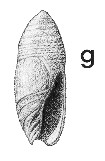
Revised descriptions of New Zealand Cenozoic Mollusca from Beu and Maxwell (1990)

 | Revised descriptions of New Zealand Cenozoic Mollusca from Beu and Maxwell (1990) | 
|
  (Pl. 22g): GS9520, J41/f8029, Awamoa Creek, Oamaru, Altonian (GNS) |
Beu & Maxwell (1990): Chapter 11; p. 204; pl. 22 g.
Synonymy: Ancillaria hebera Hutton 1873b, p. 6; Baryspira (Alocospira) hebera
Classification: Olividae: Ancillinae
Description: Rather small for genus (height 17-30 mm), elongate-ovate or bullet-shaped, spire narrowly rounded, 0.4- 0.5 total height, apex covered by spire callus. Last whorl slightly excavated adapically, sides flat or gently convex to edge of fasciole, then contracted to relatively broad anterior end. Sculpture, apart from growth lines, of spiral grooves on spire callus, more obvious on some shells than on others. Aperture elongate, narrow, constricted posteriorly; anterior notch moderately deep, fasciole covered with callus to edge of depressed band. Columella subvertical, straight or slightly concave with 2-5 weak plaits or grooves that in most shells do not extend within aperture. Parietal callus not very prominent nor extending far laterally, outer edge almost straight to concave from top of columella to base of spire callus, then bent back and concave to top of spire, forming a broadly open V.
Comparison: Olson (1956, p. 22) recorded Amalda hebera from Wharekuri Greensand (Duntroonian) at two localities and from several Waitakian localities, including Trig Z, Otiake, the type locality of Amalda (Alocospira) cuppedia. The latter species was distinguished from A. hebera primarily on the basis of its more elongate and tapering spire and on differences in the shape of the parietal callus margin. In most specimens of A. hebera the edge of the callus is distinctly concave and sweeps away from the aperture up to the spire callus, whereas in A. cuppedia it is almost straight and vertical from the top of the columella to the spire callus. Most specimens of Alocospira from Trig Z (and from Campbell Park School — also Waitakian) have a pointed spire (usually with a papillate apex) and have a parietal callus like that described for A. cuppedia, but a few have a rounded spire and a parietal callus like that of typical A. hebera. As it seems unlikely that there were two sympatric species of Alocospira during the Waitakian we must either expand the diagnosis of A. hebera to include A. cuppedia or accept that A. cuppedia includes a few individuals convergent with, or presaging A. hebera. The latter course was adopted by Beu & Maxwell (1990), at least until such time as more Waitakian material is available for study. A. electa (Duntroonian, Chatton) is also very similar to A. hebera, but in the few known specimens the margin of the parietal callus is convex rather than concave on the spire, thus giving it a sigmoidal outline. A. (Alocospira) subhebera (Tongaporutuan; Opoitian-Waipipian ?) differs from A. hebera in being still more smoothly bullet-shaped, without spiral grooves on the spire callus; it is doubtfully distinct from A. paeroa (Opoitian, southern Hawke's Bay).
The subgenus Alocospira is characterised mainly by the spiral grooves on the spire callus, and has a recorded range of Kaiatan to Waipipian in New Zealand. It is also present in the Australian Cenozoic and Recent faunas. The type species, A. papillata (Tate, 1889) (Kalimnan, Victoria) is very similar to A. hebera. Alocospira is recorded from a wide range of lithofacies, indicating a wide bathymetric distribution from shallow waters (inner shelf) down to the upper bathyal zone. Presumably, like modern Amalda species, the fossil species were carnivores, crawling just below the sediment surface on soft substrates.
Distribution: Waitakian?, Altonian; Mount Harris Formation, Awamoa, Oamaru, Altonian (type); Target Gully Shellbed; Mt Harris; Southburn Sand, White Rock River; Sutherlands.
Cite this publication as: "A.G. Beu and J.I. Raine (2009). Revised
descriptions of New Zealand Cenozoic Mollusca from Beu and Maxwell (1990). GNS
Science miscellaneous series no. 27."
© GNS Science, 2009
ISBN
978-0-478-19705-1
ISSN 1177-2441
(Included with a PDF facsimile file
copy of New Zealand Geological Survey Paleontological Bulletin 58 in CD version
from: Publications Officer, GNS Science, P.O. Box 30368 Lower Hutt, New
Zealand)